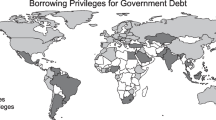Abstract
Business groups play an important role in emerging economies. The transactions cost perspective, which has dominated our understanding of such groups, argues that the emergence of business groups is a natural response to market failures in developing countries. In this paper, we propose an alternate theoretical perspective – the rent-seeking view – that takes these groups as engaging in coordinated lobbying for the capture of rents created by governments. We develop and implement an empirical strategy to test for the rent-seeking view drawing from the property rights theory of corporate finance. We find strong empirical support for the rent-seeking view using a large cross-sectional data-set of firms in India.
Similar content being viewed by others
References
Anant, T.C., Gangopadhyay, S., & Goswami, O. (1992). Industrial sickness in India – initial findings. Paper No. 2, Studies in Industrial Development, Ministry of Industry, India.
Bagchi, A. (1972). Private investment in India: 1900–1939. Cambridge: Cambridge University Press.
Bardhan, P.K. (1984). The Political Economy of Development in India. Oxford: Basil Blackwell.
Bayly, C.A. (1993). Rulers, Townsmen and Bazars. Cambridge. Cambridge University Press.
Bhagwati, J.N., Brecher, R.A., & Srinivasan, T.N. (1984). DUP activities and economic theory. In: Colander D.C. (Ed.), Neoclassical political economy (pp. 17–32). Cambridge: Ballinger.
Buchanan, J., Tellison, R., & Tulloch, G. (1980). Toward a Theory of the Rent Seeking Society. College Station,TX.: Texas A&M University Press.
Chandra, B. (1975). Jawaharlal Nehru and the Indian Capitalist Class in 1936. Economic and Political Weekly, 10, 33–35, 1307–1324.
Chang, S.J., & Choi, U. (1988). Strategy, structure and performance of Korean business groups. The Journal of Industrial Economics, 37(2), 141–157.
Chapman, S. D. (1985). British-based investment groups before 1914. Economic History Review, 38, 230–251.
Caves, R.E., & Barton, D. (1990). Efficiency in US manufacturing industries. Cambridge, Mass.: The MIT Press.
Das, G. (2002). India unbound. Profile Books. New York.
Gerlach, M. (1992). Alliance capitalism: the social organization of Japanese business. Los Angeles: University of California Press.
Goswami, O. (1985). Then came the Marwaris: Some Aspects of Change in the Pattern of Industrial Control in Eastern India. Indian Economic and Social History Review, 22(3), 225–249.
Goto, A. (1982). Business Groups in a Market Economy. European Economic Review, 19, 53–70.
Granovetter, M. (2005). Business Groups and Social Organisation. In: Smelser, N. & Swedberg, R. (Eds.), The Handbook of Economic Sociology (pp. 429–450). Princeton: Princeton University Press.
Hamilton, G., & Biggart, N. (1988). Market, Culture and Authority: A Comparative Analysis of Management and Organization in the Far East. American Journal of Sociology, 82(5), 929–964.
Hausman, J. (1978). Specification tests in econometrics. Econometrica, 46, 1251–1272.
Hoshi, T., Kashyap, A., & Scharfstein, D. (1991). Corporate Structure, Liquidity and Investment: Evidence from Japanese Industrial Groups. Quarterly Journal of Economics, 106, 33–60.
Judge, G.G., Hill, R.C., Griffiths, W.E., Lutkepohl, H., & Lee, T.C. (1988). Introduction to the Theory and Practice of Econometrics (2nd ed.). New York: Wiley.
Khanna, T., & Palepu, K. (2000). Is Group Affiliation Profitable in Emerging Markets? An Analysis of Diversified Indian Business Groups. Journal of Finance, 40(2), 867–891.
Khanna, T., & Rivkin, J. (2001). Estimating the Performance Effects of Business Groups in Emerging Markets. Strategic Management Journal, 22, 45–74.
Krueger, A.O. (1974). The Political Economy of the Rent-Seeking Society. American Economic Review, 64, 291–303.
Leff, N.H (1978). Industrial Organization and Entrepreneurship in the Developing Countries: The Economic Groups. Economic Development and Cultural Change, 26(4), 661–675
Leff, N.H. (1979). Entrepreneurship and Economic Development: The Problem Revisited. Journal of Economic Literature, 26, 46–64.
Lensink, R., Van Der Molen, R., & Gangopadhyay, S. (2003). Business Groups, Financing Constraints and Investment: The Case of India. Journal of Development Studies, 40(2), 93–119.
La Porta, R., Lopez-de-Silanes, F., & Shleifer, A. (2002). Government ownership of banks. Journal of Finance, 57, 265–301.
Majumdar, S.K. (1998). Slack in the State-Owned Enterprise: An Evaluation of the Impact of Soft-Budget Constraints. International Journal of Industrial Organization, 16(3), 377–393.
Marathe, S.S. (1989). Regulation and Development: India's Policy Experience of Controls Over Industry. New Delhi: Sage Publications.
Mohan, R., & Aggarwal, V. (1990). Commands and controls: planning for Indian industrial development, 1951–1990. Journal of Comparative Economics, 14, 681–712.
Morris, M.D. (1963). South Asian Entrepreneurship and the Rashomon effect, 1889–1947. Journal of Economic History, 16, 341–361.
Penrose, E.T. (1959). The Theory of the Growth of the Firm. Oxford: Basil Blackwell.
Ray, R. (1979): Industrialization in India: Growth and Conflict in the Private Corporate Sector (1914–1947). Delhi: Oxford University Press.
Rudolph, L.I., & Rudolph, S.H. (1987). In pursuit of Lakshmi: The Political Economy of the Indian state. Chicago: University of Chicago Press.
Sapienza, P. (2004). The Effects of Government Ownership on Bank Lending. Journal of Financial Economics, 72, 357–384.
Sarkar, J., & Agarwal, P. (1997). Banking – the Challenges of Deregulation. In: Parikh, K.S. (Ed.), India development report 1997. Delhi: Oxford University Press.
Sen, K., & Vaidya, R.R. (1997). The Process of Financial Liberalization in India. Delhi: Oxford University Press.
Shleifer, A., & Vishny, R. (1997). A Survey of Corporate Governance. Journal of Finance, 62(2), 737–783.
Tomlinson, B.R. (1993). The Economy of Modern India (1860–1970). Cambridge: Cambridge University Press.
Tullock, G. (2005). The rent-seeking society, edited by C. Rowley, Liberty Fund.
Wade, R. (1990). Governing the Market: Economic Theory and the Role of Government in East Asian Industrialization. Princeton, N.J.: Princeton University Press.
Whitley, R. (1992). European Business Systems: Firms and Markets in their National Contexts. London: Sage.
Zellner, A., & Theil, H. (1962). Three-Stage Least Squares: Simultaneous Estimation of Simultaneous Equations. Econometrica, 30, 54–78.
Author information
Authors and Affiliations
Corresponding author
Rights and permissions
About this article
Cite this article
Majumdar, S.K., Sen, K. The debt wish: Rent seeking by business groups and the structure of corporate borrowing in India. Public Choice 130, 209–223 (2007). https://doi.org/10.1007/s11127-006-9080-6
Received:
Accepted:
Published:
Issue Date:
DOI: https://doi.org/10.1007/s11127-006-9080-6




